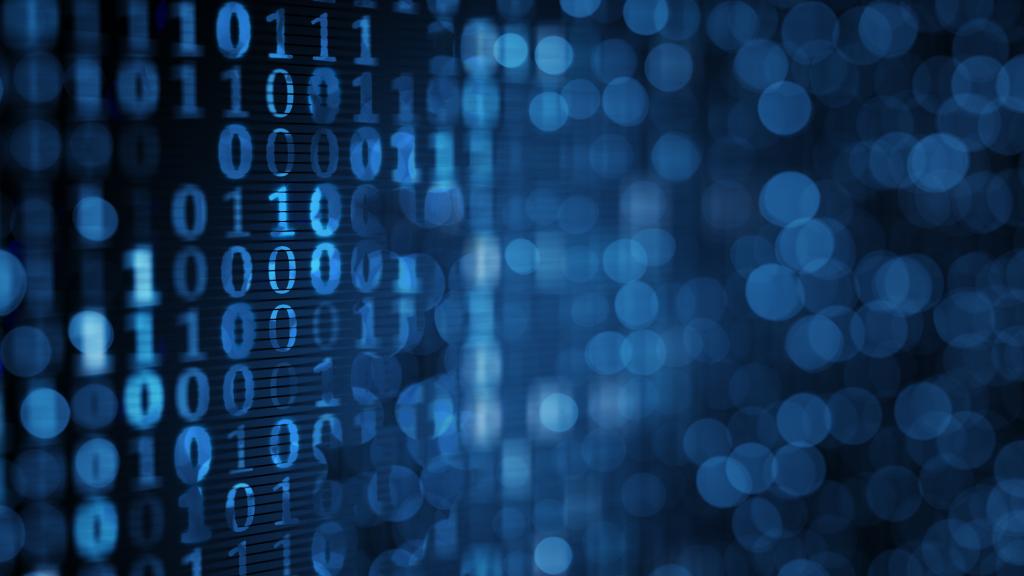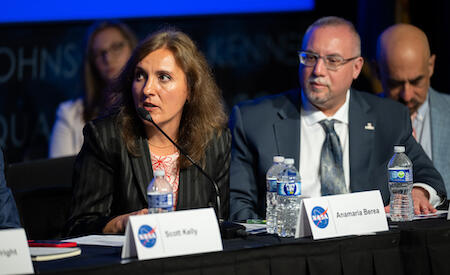Admission CTAs
Berea serves on NASA's UAP panel
Last fall NASA selected George Mason University’s Anamaria Berea to participate in its independent study team on unidentified anomalous phenomena (UAP). The 16-person panel was asked to “identify how data gathered by civilian government entities, commercial data, and data from other sources can potentially be analyzed to shed light on UAPs” and recommend a roadmap for future analysis.
Mason researcher Anamaria Berea at the NASA UAP panel on May 31, 2023. Photo by NASA
An expert in data and computational science, Berea has been working closely with the panel to carefully express the possibilities—as well as the limits—to open-source data from NASA, FAA, NOAA, and other government agencies, when studying this phenomena. While she has aspirations that this could spur a new field of study with standardized data collection, she appreciate the value of scientific rigor and has cautioned against rushing to conclusions with a high standard of evidence. The team expects to release its final report by the end of July.
Working with NASA
This is not the first time Berea has shared her computational and data science skills with NASA. After being the first woman to earn a PhD in computation social sciences at Mason, Berea saw an ad where Frontier Development Lab (FDL), an artificial intelligence (AI) research accelerator partnered with NASA and the SETI Institute, was looking for data scientists. She applied and got selected.
Her first project with NASA was within the eight-week summer challenges of FDL. The lab brings together data scientists and subject matter experts in space and earth sciences to focus on major challenges by applying data sciences, particularly machine learning and deep learning methods, to space science problems, such as the shape of asteroids, finding exoplanets, and astronaut health, among others.
“The idea is—can we come up with some artificial intelligence algorithms that can solve a big problem,” said Berea, who is an associate professor in Computational and Data Sciences Department in the College of Science.
Berea’s first challenge with the lab focused on forecasting solar flares and solar winds, which can impact the lives of the astronauts in space, as well as electronics and power grids on Earth. Then she became a mentor to an astrobiology challenge that was simulating the exoplanetary atmospheres based on metabolic networks.
Berea, who is currently affiliate faculty member with the FDL lab, was also a mentor for a challenge that designed a semi-supervised algorithm for unlabeled Earth Observation images, to automatically identify major atmospheric events in satellite imagery.
“The satellites are taking lots of pictures, but they are not labeled. We don't know what those images are without human input,” she said. “We are talking about petabytes of data that are basically impossible for the human researchers to search manually. The challenge for us was to create an algorithm that will automatically identify types of phenomena—such as a hurricane or sandstorm—in these satellite pictures.”
Another challenge she mentored last year was to create a knowledge graph, using natural language processing algorithms, to discover scientific datasets across all NASA SMD (Science Mission Directorate) fields, as well as in European Space Agency (ESA) and Japan Aerospace Exploration Agency (JAXA) repositories. For example, a scientist looking for a dataset on a specific star can find these datasets not only in astrophysics tagged data, but also heliophysics or planetary sciences.
The Science Behind the Search of Extraterrestrial Life
Berea is also an affiliate of the SETI Institute. For the uninitiated, SETI is an acronym for Search for Extraterrestrial Intelligence. Berea said, when it comes to searching for life on other planets, there are two signatures of potential life to look for: one is using biosignatures (present or past signatures of microbial or cellular life), the other is technosignatures (present or past signatures of life that developed technology in some form).
“Finding a biosignature means that you’ve found biological evidence of some sort that you can say ‘it's life,’” she said. “It can be microbial, it can be vegetation, or it can be nothing like we are used to seeing on Earth.”
“Looking for a technosignature means that we are searching for evidence of technology that might have been developed by a potentially intelligent species that is or was at some point out there,” she said. “And the technosignature can be the imprint of the satellites that are orbiting a planet, or a radio or optical wave that is out of the normal natural spectrum. Another technosignature might be an artifact from a dead civilization somewhere. The difference is that a technosignature means that there is some technology that has been developed, present or in the past, by another civilization.”
Berea said one of the big misconceptions is that if there is a discovery, it's going a specific point in time. But the truth is it will take years. “First you get the data, then you need to analyze the data, and then of course you need to have conversations and debate the discovery with so many scientists from so many fields.”
As an example, she uses a meteorite discovered during the Clinton administration that some scientists believe shows traces of past microbial life on Mars. It's been two decades, she said, and they are still debating the data and analysis from that meteorite. “The whole scientific process of validation, verification…you need to be sure when you make such a big announcement. It is a long process.”
Berea acknowledges that many scientists and much of the general public are inclined toward believing there is life is out there.
“If you're thinking just in probabilistic terms, the probability should be really high,” she said. “But the question becomes—how do you identify ‘life’?”
Berea said the search comes down to two issues. The chances of having two civilizations that are comparable in terms of technological development at the same time is one problem. The second problem is just how big the universe is.
“It's so big that any signal that we are sending now can take between hundreds and thousands of years to reach other parts of the galaxy and vice versa. The sheer vastness of the universe is the biggest barrier to actually finding something.”
Original article appeared on George Mason University's website.
Update
The team released its full report in September.

